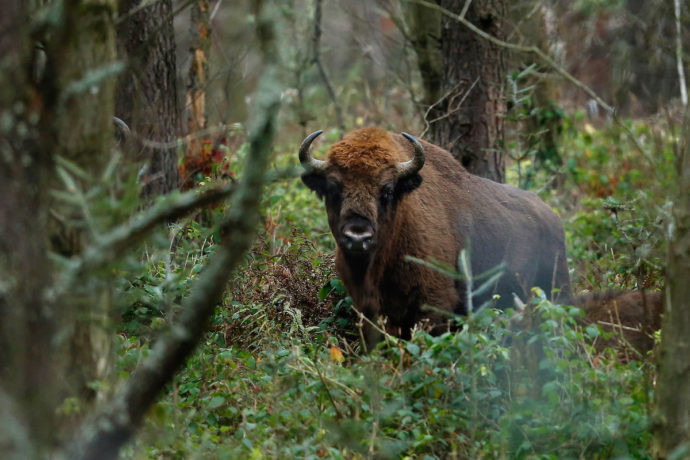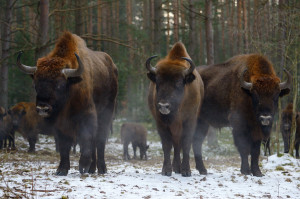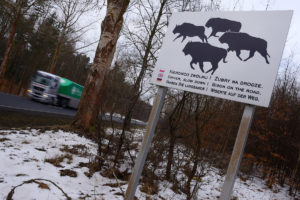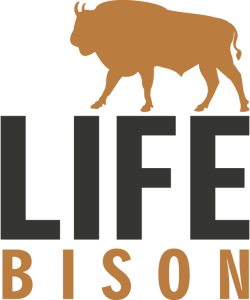The recent shooting of a wild European bison in eastern Germany highlights the urgent need to plan more carefully for wildlife comeback across our continent.

On September 14 a wild European bison was shot near the town of Lebus in eastern Germany. The previous day the bull had crossed the Oder River from Poland, having roamed naturally across the Polish countryside. Less than 24 hours later, the head of the local public order office instructed two local hunters to kill the animal – the first wild bison to stand on German soil in around 250 years – to protect the town’s population.
Understandably, this incident has caused public outrage on both sides of the border, and led people to ask how such a thing could happen.
“This animal was clearly not a danger to humans,” says Jonathan Rauhut, a member of the Rewilding Oder Delta team. “It is also obvious that the German authorities panicked and didn’t know what to do about the arrival of this strange beast. The reacted as though a dinosaur had swum across the Oder.”

Having been reintroduced in 1980, around 200 bison now populate the province of Western Pomerania in northwest Poland, on the border with Germany.
They are overseen by the Western Pomeranian Natural Society (ZTP), a Polish NGO which is also a member of the European Rewilding Network.
“These bison are totally wild,” says Marcin Grzegorzek. “Polish people are used to seeing them. And wandering bison males – such as the bull that crosssed the Oder – are also a natural phenomenon. This is the first documented bison that has crossed into Germany, but as the Western Pomeranian population increases, undoubtedly it will happen again. Wild animals don’t understand borders.”
What makes the Lebus bison incident so regrettable is that plenty of people in Germany had been made aware of the presence of bison on the Polish side of the Oder.
“The German authorities knew about the bison,” says Grzegorzek. “And they knew it was a possibility that the animals might cross the Oder. I’m not sure what happened. Maybe they didn’t expect it to happen so quickly. But evidently there was no management plan in place for such an eventuality.”

The ZTP has now sent two letters to the German authorities expressing their concerns, and offering assistance. The hugely experienced NGO has relocated bison many times, with a 24 hour Bison Emergency Service boasting trained personnel and a full range of equipment.
“If the Lebus authorities had called us we could have come immediately,” says Grzegorzek. “Even if the animal had been posing a danger, we could have relocated it. There was absolutely no need to shoot it.”
“The Province of Brandenburg (where Lebus is located) has plenty of land suitable for wild bison,” adds Rewilding Oder Delta’s Rauhut. “It’s not as if these animals cross the Oder and immediatey arrive in a hugely built up urban environment. With better planning, there is a way for these animals to recolonise the land in a trouble-free way.”
From this hugely negative and disheartening incident, we must take the positives. And also learn valuable lessons.
“What happened in Lebus was undeniably a catastrophe,” says Rauhut. “But the fact that 99% of the people in Poland and Germany have declared it a catastrophe is something we can take heart from. This shooting has raised public awareness about the presence of wild animals in Europe, and the urgent need to think more carefully about their co-existence with humans.”
Many wildlife species are now making a comeback in Europe, both of their own accord, and as a result of reintroduction.
“This comeback is clearly great news,” says Frans Schepers, Rewilding Europe’s managing director. “But in some areas we do need better communications and systems in place so that incidents like the one in Lebus don’t happen again. We want Europeans to enjoy and be inspired by their continent’s beautiful and resurgent wild nature, not feel threatened by it.”
Rewilding Europe conducts reintroduction projects in many of its operational areas. We involve local communities and stakeholders at all stages of these reintroduction projects, regardless of project scale and location. This preempts any problems that may occur after the reintroduction.

The European bison – the largest living herbivore in Europe – closely resembles its North American cousin. It once populated much of the European continent, from the Massif Central region of France in the west, to the Volga, the Caucasus and beyond in the east. But thanks to hunting and habitat loss, it was driven to extinction in the wild by 1927.
Since then, conservation efforts have reintroduced the species to countries such as Romania, Poland, Lithuania, Belarus, Ukraine, Russia and Slovakia. It is still identified as a vulnerable species on the International Union for Conservation of Nature’s Red List.
 With wild bison hunted to extinction in Romania around 200 years ago, Rewilding Europe and WWF Romania began reintroducing bison into the country’s Southern Carpathian mountains in 2014. This became a European Union-supported LIFE-Bison project in 2016. Earlier this year, three new bison calves were born into the reintroduced herds, which now boast a collective population of around 50 animals.
With wild bison hunted to extinction in Romania around 200 years ago, Rewilding Europe and WWF Romania began reintroducing bison into the country’s Southern Carpathian mountains in 2014. This became a European Union-supported LIFE-Bison project in 2016. Earlier this year, three new bison calves were born into the reintroduced herds, which now boast a collective population of around 50 animals.
More information about the LIFE-Bison project can be found here.
More information about Rewilding Europe’s work in the Southern Carpathians can be found here.
